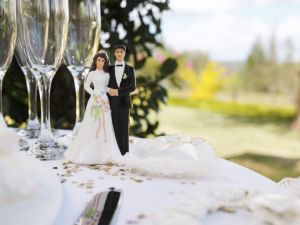 In the age of globalization, a rise in the number of marriages between people of different cultural origins should come as no surprise. As a wedding officiant, you can play a significant part in helping people to blend their traditions and their hearts through an interfaith ceremony that is inclusive and respectful of all. Whether the happy couple are Buddhist and Jewish, Hindu and Christian, Wiccan and Atheist or any other combination, their wedding may reflect the harmony they seek in marriage. Fortunately, there are many ways to honor the spirit of the event, their relationship and their chosen guests so that all feel at ease and are prepared to joyfully celebrate the union.
In the age of globalization, a rise in the number of marriages between people of different cultural origins should come as no surprise. As a wedding officiant, you can play a significant part in helping people to blend their traditions and their hearts through an interfaith ceremony that is inclusive and respectful of all. Whether the happy couple are Buddhist and Jewish, Hindu and Christian, Wiccan and Atheist or any other combination, their wedding may reflect the harmony they seek in marriage. Fortunately, there are many ways to honor the spirit of the event, their relationship and their chosen guests so that all feel at ease and are prepared to joyfully celebrate the union.
Math to the Rescue!
It may be natural to want to include all the best parts of everyone's traditions, but that task may present logistical challenges that feel overwhelming. The key is to find a common denominator. Just as in grade school, a common denominator will help you work with factors that may appear unlike at first. The simplest place to start may be the most obvious. As the officiant, address the reason everyone is gathered, and that is to celebrate the love between the two people joining their lives and families. Talk about the love in the room, and how honored and grateful the two people are to share this sacred moment in the company of family and friends. It is not always possible to please everyone, but it is more than possible to clear a path for celebration.
Hold a Sacred Ceremony
A ceremony that is not tied to specific religious practices may still embody a spiritual feel that honors and marks the importance of the occasion. Assuming it is correct to do so, you may include rituals from religious practices that connect with the couple's wishes. There are a number of ways to enrich the service in a natural manner that echo many traditional rituals:
- Offer a blessing. This can be a broad statement that avoids the specific use of the words God or Goddess.
- Honor the family and guests and express gratitude for their presence.
- Modify a Wiccan practice by joining hands in a hand blessing.
- Reflect a Catholic tradition by lighting a unity candle to symbolize the blending of two people.
- Conduct a reading, perhaps from a favorite book of essays or poems.
- Select music that resonates for the couple.
- Encourage the people getting married to compose their own vows. A few hand-written words may truly speak from the heart.
Adopt a Ritual for the Occasion
While many weddings over the centuries have been conducted under different religious parameters, there is an abundance of ceremonial practices that may be borrowed without invoking any one religious tradition. These activities may help offer another layer to the ceremony and deepen the guests' engagement with it:
- A sand ritual. This is a terrific visual and also a way for guests to participate in the event. Each person in attendance pours some colored sand into a clear container. The result is a beautiful layered sculpture that symbolizes the joining of two people, two families and two lives.
- A wine ceremony. The chalice serves as a symbol of union in this practice. It is filled with all the couple's hopes, dreams, fears and challenges. As they sip from the chalice, they acknowledge their commitment to this new and lifelong journey.
There are many other opportunities for ritual in addition to these. It is a well-known practice for a glass to be broken at a traditional Jewish wedding, but old Italian customs embrace this, too. A little research may turn up many possibilities for creating a harmonious, meaningful and inclusive wedding ceremony for any couple and their loved ones.
Add Your Comment